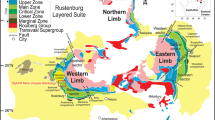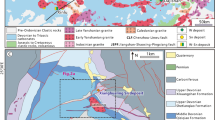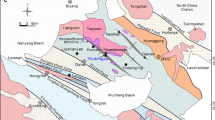Abstract
Between 70 and 175 ka, over 350 km3 of high-silica rhyolite magma erupted both effusively and explosively from within the Yellowstone Caldera. Phenocrysts in all studied lavas and tuffs are remarkably homogenous at the crystal, eruption, and caldera-scale, and yield QUILF temperatures of 750 ± 25 °C. Phase equilibrium experiments replicate the observed phenocryst assemblage at those temperatures and suggest that the magmas were all stored in the upper crust. Quartz-hosted glass inclusions contain 1.0–2.5 % H2O and 50–600 ppm CO2, but some units are relatively rich in CO2 (300–600 ppm) and some are CO2-poor (50–200 ppm). The CO2-rich magmas were stored at 90–150 MPa and contained a fluid that was 60–75 mol% CO2. CO2-poor magmas were stored at 50–70 MPa, with a more H2O-rich fluid (\(X_{{{\text{CO}}_{2} }}\) = 40–60 %). Storage pressures and volatiles do not correlate with eruption age, volume, or style. Trace-element contents in glass inclusions and host matrix glass preserve a systematic evolution produced by crystal fractionation, estimated to range from 36 ± 12 to 52 ± 12 wt%. Because the erupted products contain <10 wt% crystals, crystal-poor melts likely separated from evolving crystal-rich mushes prior to eruption. In the Tuffs of Bluff Point and Cold Mountain Creek, matrix glass is less evolved than most inclusions, which may indicate that more primitive rhyolite was injected into the reservoir just before those eruptions. The presence and dissolution of granophyre in one flow may record evidence for heating prior to eruption and also demonstrate that the Yellowstone magmatic system may undergo rapid changes. The variations in depth suggest the magmas were sourced from multiple chambers that follow similar evolutionary paths in the upper crust.









Similar content being viewed by others
References
Almeev RR, Bolte T, Nash BP, Holtz F (2012) High-temperature, low-H2O silicic magmas of the yellowstone hotspot: an experimental study of rhyolite from the Bruneau-Jarbidge Eruptive Center, Central Snake River Plain, USA. J Petrol 53:1837–1866
Andersen DJ, Lindsley DH, Davidson PM (1993) QUILF: a pascal program to assess equilibria among Fe–Mg–Mn–Ti oxides, pyroxenes, olivine, and quartz. Comp Geosci 19:1333–1350
Bachmann O, Bergantz GW (2004) On the origin of crystal-poor rhyolites: extracted from batholithic crystal mushes. J Petrol 45:1565–1582
Bachmann O, Dungan MA, Lipman PW (2002) The fish canyon magma body, San Juan volcanic field, Colorado: rejuvenation and eruption of an upper-crustal batholith. J Petrol 43:1469–1503
Barker DS (1970) Compositions of granophyre, myrmekite, and graphic granite. Geol Soc Am Bull 81:3339–3350
Befus KS, Gardner JE, Zinke RW (2012) Analyzing water contents in unexposed glass inclusions in quartz crystals. Am Mineral 97:1898–1904
Befus KS, Zinke RW, Jordan JS, Manga M, Gardner JE (2014) Pre-eruptive storage conditions and eruption dynamics of a small rhyolite dome: Douglas Knob, Yellowstone volcanic field, USA. Bull Volcanol 76:1–12
Behrens H, Tamic N, Holtz F (2004) Determination of the molar absorption coefficient for the infrared absorption band of CO2 in rhyolitic glasses. Am Mineral 89:301–306
Bindeman IN, Valley JW (2000) Formation of low-δ18O rhyolites after caldera collapse at Yellowstone, Wyoming, USA. Geology 28:719–722
Bindeman IN, Valley JW (2001) Low-δ18O rhyolites from Yellowstone: magmatic evolution based on analyses of zircons and individual phenocrysts. J Petrol 42:1491–1517
Bindeman IN, Valley JW, Wooden JL, Persing HM (2001) Post-caldera volcanism: in situ measurement of U–Pb age and oxygen isotope ratio in Pleistocene zircons from Yellowstone Caldera. Earth Planet Sci Lett 189:197–206
Bindeman IN, Fu B, Kita, NT, Valley JW (2008) Origin and evolution of silicic magmatism at Yellowstone based on ion microprobe analysis of isotopically zoned zircons. J Petrol 49:163–193
Bolte M, Holtz F, Almeev R, Nash B (2015) The Blacktail Creek Tuff: an analytical and experimental study of rhyolites from the Heise volcanic field, Yellowstone hotspot system. Contrib Mineral Petrol 169:1–24
Branney MJ, Bonnichsen B, Andrews GDM, Ellis B, Barry TL, McCurry M (2008) “Snake River (SR)-type” volcanism at the Yellowstone hotspot track: distinctive products from unusual, high-temperature silicic super-eruptions. Bull Volcanol 70:293–314
Cathey HE, Nash BP (2009) Pyroxene thermometry of rhyolite lavas of the Bruneau-Jarbidge eruptive center, Central Snake River Plain. J Volcanol Geotherm Res 188:173–185
Chang W-L, Smith RB, Wicks C, Farrell JM, Puskas CM (2007) Accelerated uplift and magmatic intrusion of the Yellowstone Caldera, 2004 to 2006. Science 318:952–956
Christiansen RL (2001) The quaternary and pliocene Yellowstone plateau volcanic field of Wyoming, Idaho, and Montana. USGS Prof Paper 729-G
Christiansen EH, McMurry M (2008) Constrasting origins of Cenozoic silicic volcanic rocks from the western Cordillera of the United States. Bull Volcanol 70:251–267
Christiansen RL, Lowenstern JB, Smith RB, Heasler H, Morgan LA, Nathenson M, Mastin LG, Muffler LJP, Robinson JE (2007) Preliminary assessment of volcanic and hydrothermal hazards in Yellowstone National Park and vicinity. USGS Open-file report 2007-1071
Chu R, Helmberger DV, Sun D, Jackson JM, Zhu L (2010) Mushy magma beneath Yellowstone. Geophys Res Lett. doi:10.1029/2009GL041656
DeNosaquo KR, Smith RB, Lowry AR (2009) Density and lithospheric strength models of the Yellowstone-Snake River Plain volcanic system from gravity and heat flow data. J Volcanol Geotherm Res 188:108–127. doi:10.1016/jjvolgeores200908006
Ellis BS, Barry T, Branney MJ (2010) Petrologic constraints on the development of a large-volume, high temperature, silicic magma system: the Twin Falls eruptive centre, central Snake River Plain. Lithos 120:475–489
Ellis BS, Mark DF, Pritchard CJ, Wolff JA (2012) Temporal dissection of the Huckleberry Ridge Tuff using the 40Ar/39Ar dating technique. Quat Geochronol 9:34–41
Farrell J, Husen S, Smith RB (2009) Earthquake swarm and b-value characterization of the Yellowstone volcano-tectonic system. J Volcanol Geotherm Res 188:260–276
Farrell J, Smith RB, Husen S, Diehl T (2014) Tomography from 26 years of seismicity revealing that the spatial extent of Yellowstone crustal magma reservoir extends well beyond the Yellowstone Caldera. Geophys Res Lett 41:3068–3073
Gansecki CA (1998) 40Ar/39Ar geochronology and pre-eruptive geochemistry of the Yellowstone Plateau volcanic field rhyolites. UMI Dissertation Services, Stanford
Gansecki CA, Lowenstern JB (1995) Pre-eruptive volatile compositions of the Lava Creek Tuff magma, Yellowstone Plateau Volcanic Field. Trans Am Geophys Union Eos 76:F665
Gansecki CA, Mahood GA, McWilliams MO (1996) 40Ar39Ar geochronology of rhyolites erupted following collapse of the Yellowstone Caldera, Yellowstone Plateau volcanic field: implications for crustal contamination. Earth Planet Sci Lett 142:91–107
Gardner JE, Rutherford M, Carey S, Sigurdsson H (1995) Experimental constraints on pre-eruptive water contents and changing magma storage prior to explosive eruptions of Mount St Helens volcano. Bull Volcanol 57:1–17
Gardner JE, Befus KS, Gualda GAR, Ghiorso MS (2014) Experimental constraints on rhyolite-MELTS and the Late Bishop Tuff magma body. Contrib Mineral Petrol 168:1051
Giordano D, Russell DK, Dingwell DB (2008) Viscosity of magmatic liquids: a model. Earth Planet Sci Lett 271:123–134
Girard G, Stix J (2009) Magma recharge and crystal mush rejuvenation associated with early post-collapse Upper Basin Member Rhyolites, Yellowstone Caldera, Wyoming. J Petrol. doi:10.1093/petrology/egp070
Girard G, Stix J (2010) Rapid extraction of discrete magma batches from a large differentiating magma chamber: the Central Plateau Member rhyolites, Yellowstone Caldera, Wyoming. Contrib Mineral Petrol 160:441–465
Girard G, Stix J (2012) Future volcanism at Yellowstone Caldera: insights from geochemistry of young volcanic units and monitoring of volcanic unrest. GSA Today. doi:10.1130/GSATG143A1
Hildreth W (2004) Volcanological perspectives on Long Valley, Mammoth Mountain, and Mono Craters: several contiguous but discrete systems. J Volcanol Geotherm Res 136:169–198
Hildreth W, Halliday AN, Christiansen RL (1991) Isotopic and chemical evidence concerning the genesis and contamination of basaltic and rhyolitic magma beneath the Yellowstone Plateau volcanic field. J Petrol 32:63–138
Honjo N, Bonnichsen B, Leeman WP (1992) Mineralogy and geothermometry of high-temperature rhyolites from the central and western Snake River Plain. Bull Volcanol 54:220–237
Huang R, Audetat A (2012) The titanium-in-quartz (TitaniQ) thermobarometer: a critical examination and re-calibration. Geochim Cosmochim Acta 84:75–89
Huber C, Bachmann O, Dufek J (2012) Crystal-poor versus crystal-rich ignimbrites: a competition between stirring and reactivation. Geology 40:115–118
Lanphere MA, Champion DE, Christiansen RL, Izett GA, Obradovich JD (2002) Revised ages for tuffs of the Yellowstone Plateau volcanic field: assignment of the Huckleberry Ridge Tuff to a new geomagnetic polarity event. Geol Soc Am Bull 114:559–568
Leeman WP, Phelps DW (1981) Partitioning of rare earths and other trace elements between sanidine and coexisting volcanic glass. J Geophys Res 86:10193–10199
Lipman P, Dungan M, Bachmann O (1997) Comagmatic granophyric granite in the Fish Canyon Tuff, Colorado: implications for magma-chamber processes during a large ash-flow eruption. Geology 25:915–918
Liu Y, Zhang Y, Behrens H (2005) Solubility of H2O in rhyolitic melts at low pressures and a new empirical model for mixed H2O–CO2 solubility in rhyolitic melts. J Volcanol Geotherm Res 143:219–235
Loewen MW, Bindeman IN (2015) Oxygen isotope and trace element evidence for three-stage petrogenesis of the youngest episode (260–79 ka) of Yellowstone rhyolitic volcanism. Contrib Mineral Petrol 170:1–25
Lowenstern JB, Hurwitz S (2008) Monitoring a supervolcano in repose: heat and volatile flux at the Yellowstone Caldera. Elements 40:35–40
Lowenstern JB, Clynne MA, Bullen TD (1997) Comagmatic A-type granophyre and rhyolite from the Alid Volcanic Center, Eritrea, Northeast Africa. J Petrol 38:1707–1721
Lowenstern JB, Smith RB, Hill DP (2006) Monitoring super-volcanoes: geophysical and geochemical signals at Yellowstone and other large caldera systems. Philos Trans R Soc Lon 364:2055–2072
Morgan GB, London D (2012) Process of granophyre crystallization in the Long Mountain Granite, southern Oklahoma. Geol Soc Am Bull 124:1251–1261
Nielsen CH, Sigurdsson H (1981) Quantitative methods for electron microprobe analysis of sodium in natural and synthetic glasses. Am Mineral 66:547–552
Pelton JR, Smith RB (1979) Recent crustal uplift in Yellowstone National Park. Science 206:1179–1182
Pritchard CJ, Larson PB (2012) Genesis of the post-caldera eastern Upper Basin Member rhyolites, Yellowstone, WY: from volcanic stratigraphy, geochemistry, and radiogenic isotope modeling. Contrib Mineral Petrol 164:205–228
Pyle DM (1989) The thickness, volume and grainsize of tephra fall deposits. Bull Volcanol 51:1–15
Rutherford MJ (2008) Magma ascent rates. Rev Mineral Geochem 69:241–271
Skirius CM, Peterson JW, Anderson AT (1990) Homogenizing rhyolitic glass inclusions from the Bishop Tuff. Am Mineral 75:1381–1398
Smith RB, Jordan M, Steinberger B, Puskas CM, Farrell J, Waite GP, Husen S, Chang W-L, O’Connell R (2009) Geodynamics of the Yellowstone hotspot and mantle plume: seismic and GPS imaging, kinematics, and mantle flow. J Volcanol Geotherm Res 188:26–56
Stelten ME, Cooper KM, Vazquez JA, Reid MR, Garfod GH, Wimpenny J, Qing-zhu Y (2013) Magma mixing and the generation of isotopically juvenile silicic magma at Yellowstone Caldera inferred from coupling 238U–230Th ages with trace elements and Hf and O isotopes in zircon and Pb isotopes in sanidine. Contrib Mineral Petrol 166:587–613
Stelten ME, Cooper KM, Vazquez JA, Calvert AT, Glessner JJG (2015) Mechanisms and timescales of generating eruptible rhyolitic magmas at Yellowstone Caldera from zircon and sanidine geochronology and geochemistry. J Petrol 56:1607–1642
Thomas JB, Watson BE, Spear FS, Shemella PT, Nayak SK, Lanzirotti A (2010) TitaniQ under pressure: the effect of pressure and temperature on the solubility of Ti in quartz. Contrib Mineral Petrol 160:743–759
Thomas JB, Watson BE, Spear FS, Wark DA (2015) TitaniQ recrystallized: experimental confirmation of the original Ti-in-quartz calibrations. Contrib Mineral Petrol 169:1–16
Till CB, Vazquez JA, Boyce JW (2015) Months between rejuvenation and volcanic eruption at Yellowstone Caldera, Wyoming. Geology 43:695–698
Vazquez JA, Reid MR (2002) Time scales of magma storage and differentiation of voluminous high-silica rhyolites at Yellowstone Caldera, Wyoming. Contrib Mineral Petrol 144:274–285
Vazquez JA, Kyriazis SF, Reid MR, Sehler RC, Ramos FC (2009) Thermochemical evolution of young rhyolites at Yellowstone: evidence for a cooling but periodically replenished postcaldera magma reservoir. J Volcanol Geotherm Res 188:186–196
Walker GPL, Huntingdon AT, Sanders AT, Dinsdale JL (1973) Lengths of lava flows [and discussion]. Phils Trans R Soc Lond 274:107–118
Wark DA, Watson EB (2006) TitaniQ: a titanium-in-quartz geothermometer. Contrib Mineral Petrol 152:743–754
Watts KE, Bindeman IN, Schmitt AK (2012) Crystal scale anatomy of a dying supervolcano: an isotope and geochronology study of individual phenocrysts from voluminous rhyolites of the Yellowstone Caldera. Contrib Mineral Petrol 164:45–67
Wicks CW, Thatcher W, Dzurisin D, Svarc J (2006) Uplift, thermal unrest and magma intrusion at Yellowstone Caldera. Nature 440:72–75
Wolff JA, Ellis BS, Ramos FC (2011) Strontium isotopes and magma dynamics: insights from high-temperature rhyolites. Geology 39:931–934
Zhang Y, Belcher R, Ihinger PD, Wan L, Xu Z, Newman S (1997) New calibration of infrared measurement of dissolved water in rhyolitic glasses. Geochim Cosmochim Acta 61:3089–3100
Acknowledgments
We thank Robert Zinke, Matt Williams, Ryan Cahalan, Kevin Befus, Tim Prather, Jake Jordan, Brent Jackson, Gail Mahood and Jim Watkins for scientific conversations and their assistance in the field. We also thank Renat Almeev, Mark Stelten, Jorge Vazquez, Kathryn Watts, and 3 anonymous reviewers for helpful reviews. Nathan Miller operated the LA-ICP-MS and helped process the trace-element data. This research was made possible by a grant from the National Science Foundation (EAR-1049829) to J.E.G and a National Park Service research permit (YELL-05678).
Author information
Authors and Affiliations
Corresponding author
Additional information
Communicated by Gordon Moore.
Electronic supplementary material
Below is the link to the electronic supplementary material.
Rights and permissions
About this article
Cite this article
Befus, K.S., Gardner, J.E. Magma storage and evolution of the most recent effusive and explosive eruptions from Yellowstone Caldera. Contrib Mineral Petrol 171, 30 (2016). https://doi.org/10.1007/s00410-016-1244-x
Received:
Accepted:
Published:
DOI: https://doi.org/10.1007/s00410-016-1244-x




